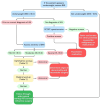Corneal Refractive Surgery Considerations in Patients with Anorexia Nervosa
- PMID: 39737364
- PMCID: PMC11682940
- DOI: 10.2147/OPTH.S497690
Corneal Refractive Surgery Considerations in Patients with Anorexia Nervosa
Abstract
Anorexia nervosa (AN) is a psychiatric eating disorder characterized by body mass index (BMI) ≤ 18.5, fear of gaining weight, and a distorted perception of body weight. With increasing rates of myopia, there is a population of patients who concurrently develop AN and may seek corneal refractive surgery. This study reviews the ophthalmic manifestations of AN and provides preliminary guidelines for patients with AN undergoing corneal refractive surgery. The literature search was conducted through the PubMed, Scopus, and Ovid databases through June 2, 2024, for publications detailing the ocular manifestations of AN. These findings were then considered in the context of potential complications after corneal refractive surgery, and preoperative guidelines for patients with AN were formulated. Twelve articles described a total of 114 patients with AN (227 eyes) with ophthalmic manifestations. Among the studied eyes, 14% had ocular surface abnormalities, 5% had cataracts/visual disturbances, 64% had posterior segment abnormalities, and 20% had orbital/neurological abnormalities. Various ophthalmic findings of AN may increase the risk of delayed corneal wound healing, ocular surface dryness, perioperative bleeding, flap-related complications, and poor visual outcomes after corneal refractive surgery. The BMI of patients suspected with AN must be assessed, and patients should be screened for diagnosis of AN. If mildly and moderately underweight patients with AN have normal ophthalmic and medical workups, they may proceed with a typical preoperative workup for corneal refractive surgery. Ultimately, the decision to recommend elective corneal refractive surgery for these patients rests with the surgeon. This study should be considered a foundation for future research, encouraging collaboration across medical disciplines to develop more comprehensive guidelines for managing this patient population.
Keywords: LASIK; PRK; SMILE; eating disorder; guidelines; ophthalmic manifestation.
© 2024 Moshirfar et al.
Conflict of interest statement
No funding or financial support was provided for the conception or formulation of the study. The authors declare that they have no conflict of interest.
Figures
Similar articles
-
Past and present of corneal refractive surgery: a retrospective study of long-term results after photorefractive keratectomy and a prospective study of refractive lenticule extraction.Acta Ophthalmol. 2014 Mar;92 Thesis 2:1-21. doi: 10.1111/aos.12385. Acta Ophthalmol. 2014. PMID: 24636364
-
Phakic intraocular lenses for the treatment of refractive errors: an evidence-based analysis.Ont Health Technol Assess Ser. 2009;9(14):1-120. Epub 2009 Oct 1. Ont Health Technol Assess Ser. 2009. PMID: 23074518 Free PMC article.
-
Review of Laser Vision Correction (LASIK, PRK and SMILE) with Simultaneous Accelerated Corneal Crosslinking - Long-term Results.Curr Eye Res. 2019 Nov;44(11):1171-1180. doi: 10.1080/02713683.2019.1656749. Epub 2019 Aug 23. Curr Eye Res. 2019. PMID: 31411927 Review.
-
Intrastromal corneal ring implants for corneal thinning disorders: an evidence-based analysis.Ont Health Technol Assess Ser. 2009;9(1):1-90. Epub 2009 Apr 1. Ont Health Technol Assess Ser. 2009. PMID: 23074513 Free PMC article.
-
Ectasia After Corneal Refractive Surgery: A Systematic Review.Ophthalmol Ther. 2021 Dec;10(4):753-776. doi: 10.1007/s40123-021-00383-w. Epub 2021 Aug 20. Ophthalmol Ther. 2021. PMID: 34417707 Free PMC article. Review.
References
-
- American Psychiatric Association. Feeding and Eating Disorders. Diagnostic and Statistical Manual of Mental Disorders. 5th. Washington D.C. 2013.
Publication types
LinkOut - more resources
Full Text Sources


